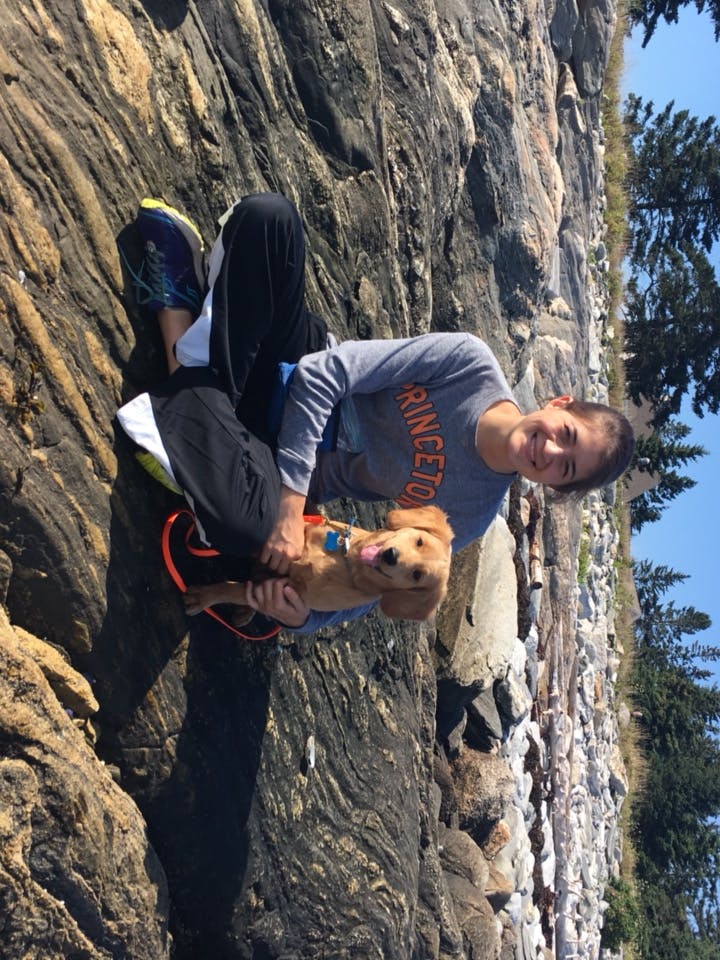Camden Olson ‘19 never had a pet dog growing up, but a story she read in the seventh grade sparked an interest in training service dogs. That passion has shaped her experiences ever since: from training neighborhood dogs in her hometown of Chicago, to spending a gap year at a guide dog school in Maine, to basing her senior thesis on Koa, a miniature golden retriever Olson is training to be a diabetic alert dog.
“Since I wasn’t allowed to have a dog, I would do everything that I could to train and work with dogs – I’d watch TV shows, read books about it, I did an independent study in high school and worked with the neighbors’ dog, anything I could,” she explained.
After graduating high school, Olson wanted to delve deeper into the world of service dog training. Her grandmother, who had encouraged Olson to get involved with dog training, lived in Maine, and Olson moved there for a year to begin training a guide dog. She also worked in a dental clinic, helped teach obedience classes, and taught dog safety in schools. At the end of the year, the guide dog that she trained was successfully placed with a new owner in California.
Olson spent a year and a half in an extended approval process that ultimately allowed her to train a service dog while at school. Koa will be a diabetic alert dog, trained to paw at his owner when he smells that their blood sugar is too high or too low. Olson began working with him early in the summer, when he was just eight weeks old. She used saliva samples to help him develop the ability to determine whether a person’s blood sugar levels are out of balance. By the time he was three and a half months old, Koa was able to “live alert” – to paw at Olson when her blood sugar was lower than usual.
At the end of the summer, Olson moved Koa into her University dorm room. She has continued his training on campus ever since, and hopes to place him with a Type 1 diabetic at the end of the school year.
“I love having Koa in the room – it's like always having a puppy study break!” Madeleine Cheyette ‘19, Olson’s roommate, said. “Camden is really, really great at training him. You can tell that this is something she's so passionate about. I'm really happy this work was approved for her.”
Olson said that the experience of training a service dog has helped her become more aware of her day-to-day emotions.

“Everything is about feeding off of my energy. I have to really be 'on' all the time, I have to be in the moment, monitoring my emotions,” Olson said. “I’ll often find that Koa’s behavior is representative of how I’m feeling. If he is kind of blowing me off, pulling on the leash all the time, I find it’s usually because I’m stressed about something. If I take a moment to collect myself and take a deep breath, he’ll walk safely.”
“You have to be really, really patient all the time,” she added. “Sometimes it’s hard, especially because I’m the only one taking care of him right now.”
Olson is incorporating her work with Koa into her senior thesis in the Department of Ecology and Evolutionary Biology. Her research on guide dog training is done, in part, by tracking Koa’s alerting behavior, and will also help middle school students learn to train service dogs.

“I designed an after-school program that teaches middle school students how to train service dogs, so I’m going to teach it and use Koa and see how it affects the students’ academic and socio-emotional markers,” Olson said.
After graduation, Olson plans to continue researching canine cognition and ways to the improve the efficiency of service dog training.
“The dog training field is not very unified; there are a lot of different mentalities and ways of approaching things. If you asked two different dog trainers for an opinion, they’d probably give you two different answers,” Olson said. “I want to get more research behind which methods work and which don’t, because there’s really not that much information.”
Olson explained that the process of training a service dog is far different than having a pet: there’s a purpose behind the experience that makes placing the dog with a new owner meaningful rather than sad.
“It’s something I’ve been gearing up towards my whole life,” Olson said. “I feel like this is a necessary part of my college education. I learn so much every single day.”





